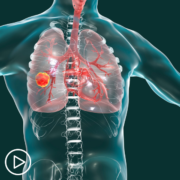Tag Archive for: Non-Small Cell Lung Cancer treatment
Non-Small Cell Lung Cancer Essential Testing | What You Should Know
Non-Small Cell Lung Cancer Essential Testing | What You Should Know from Patient Empowerment Network on Vimeo.
What tests are needed for a lung cancer diagnosis, and how might the results affect treatment options? Dr. Erin Schenk reviews the most common tests for lung cancer, including biomarker testing, and how the results may be used to determine the most appropriate therapy for your particular disease.
Dr. Erin Schenk is a medical oncologist, lung cancer researcher, and assistant professor in the division of medical oncology at the University of Colorado Anschutz Medical Center.
See More From INSIST! Lung Cancer
Related Resources:

|

|

Personalized Lung Cancer Treatment | Key Factors to Consider |
Transcript:
Katherine Banwell:
What are the various subtypes of lung cancer, and how are they identified?
Dr. Erin Schenk:
Absolutely. So, there are a number of different subtypes of lung cancer that are important for us to identify, because it helps to stratify or helps to select the right treatment approaches for a patient. So, usually when someone is diagnosed with lung cancer there was a scan done at some point that noticed a mass or masses in the body.
What happens next is a biopsy happens where a needle is used to sample the tissue, and that could be in the lung, that could be in lymph nodes or other parts of the body and that tissue that’s sampled is first sent to my colleagues in pathology.
And they’re a group of doctors who look at tissues underneath the microscope and try to identify what those are. And based on that initial pathology analysis, we can identify usually pretty straightforward, what is the type of cancer that they see under the microscope.
And so, in very general terms there are non-small cell lung cancers, there is a group called small cell lung cancers, and there’s also a group called neuroendocrine cancers as well. Oftentimes, times we’re able to differentiate these types of tumors, these types of lung cancers based on how different markers show up, and these are called stains.
And these stains can differentiate non-small cell between adenocarcinoma versus squamous cell carcinoma. And then they can also help differentiate small cell lung cancer. And then, of course, they can also help to identify if this is a neuroendocrine tumor.
Katherine Banwell:
Today we’re going to focus on non-small cell lung cancer. Are there specific tests that patients should ask their doctor for following a diagnosis?
Dr. Erin Schenk:
Absolutely, and I think it’s sometimes helpful to understand what are all the pieces of information I need when I first meet a patient to make decisions about treatments? So, we just went over the histology or another word, the pathology, what does the cancer look like underneath – under the microscope? That can help and that’s one of the pieces, understanding what type of non-small cell lung cancer is present.
Additional information that’s needed includes certain tests, and you might hear say like, molecular testing or sequencing.
Those pieces of information can be really important for treatment selection. So, whether there’s a diagnosis of adenocarcinoma or squamous cell lung cancer, we always try to know the PD-L1 status. And that’s actually a surface marker that’s present on the outside of the cancer cells and is able to help us select immunotherapy treatments as appropriate.
Oftentimes, patients with lung adenocarcinoma will get further sequencing of the tumor itself. And again, you might hear of this called molecular testing or next-generation sequencing, NGS. There are a lot of terms we use for it, but fundamentally, what we’re trying to do is understand the vulnerabilities of the cancer cells.
And these vulnerabilities can be identified by these molecular tests. They often are able to recognize mutations or fusions or genetic changes within the cancer cells that are present. This is critically important, because we have a whole number of oral targeted therapies that can go after these mutations or alterations, and in other words, they go after the vulnerability in the cancer cells. That’s the adenocarcinoma histology.
That’s the majority of non-small cell lung cancer diagnoses but I think also if you have been told your diagnosis is of squamous lung cancer, classically we don’t often think of those driver alterations or those fusions or mutations that I just spoke about. But I think it’s also quite important for patients in that situation to also undergo molecular testing.
As we learn more and more, sometimes those squamous lung cancers can also bear those same alterations. Not to the same frequency, but they can be present, and I think it’s important as you’re thinking about a patient to try to understand what are all the tools I have for them to do that sequencing just to make sure you’re not missing something. So, that’s a really in-depth look to molecular testing.
I’d like to transition to some of the other tests that would be necessary to help put that molecular testing in context. Another important piece is something called staging. And staging is a way to determine if the lung cancer has traveled elsewhere in the body.
Sometimes it can be involved in the lymph nodes of the middle of the chest. Sometimes it can go outside the chest. For example, to the bones or the liver or the brain, and understanding that information, understanding that lay of the land before we start treatment, is really important, not only for treatment selection, like the treatments, the medicines I would give as a medical oncologist.
But also, in thinking about which other colleagues of mine who help take care of patients with lung cancer should I also involve in some of these treatment decisions. So, staging can often involve CT scans of the chest, abdomen, pelvis. A PET scan can be done. As well as an MRI of the brain.
Katherine Banwell:
Dr. Schenk, I just want to confirm that you’ve been speaking about molecular testing, that’s the same as biomarker testing, right?
Dr. Erin Schenk:
Exactly. Exactly.
Katherine Banwell:
And how is it performed?
Dr. Erin Schenk:
So, biomarker testing, molecular testing, NGS, there’s a whole range of synonyms we use, that is done primarily on the tumor tissue.
So, the first test that usually comes back is a marker on the cancer cell.
That’s PD-L1. That is an IHC test that is able to be done pretty quickly and we’re able to have a turnaround time of just a few days to understand that first biomarker. But the PD-L1 status does not make sense unless we have all of the other information to get the best context, the best understanding of the tumor and what drives the tumor. That additional testing is actually the next-generation sequencing where the genetic material of cancer cells, the DNA and RNA is sequenced in a laboratory to look for those mutations or fusions or other alterations that can drive the cancer cells. And again, it helps me identify additional vulnerabilities in the cancer cells to allow me to pick the optimal therapy for the patient in front of me.
The tissue testing is the gold standard and we try to get all of our answers from the tissue. Sometimes we’re also able to get additional information from the blood, and that’s what’s called a liquid biopsy. Cancer cells – in some patients, cancer cells shed their genetic material into the bloodstream.
And these specialized tests are able to pick up that genetic material, have the sequencing done on that, and then report back to me about what may or may not be found.
Now, as I mentioned, not all of lung cancers shed this information into the blood, so it’s not – if the blood does not reveal an answer or information, that’s – we still need to look closer at the tissue, but occasionally if the blood reveals certain alterations, that can be acted upon, and we don’t have to wait for the tissue testing.
I think one of the challenges that I absolutely sympathize with their biomarker or molecular testing is that it can take a series of weeks to really get all of the information necessary to make the best choice for the patient in front of us.
And I have a – I have a saying I like to share with patients that is really important and I think really fundamental to the treatment choices for patients with lung cancer and that is, it’s better to get started on the right treatment rather than the fast one, and that’s true. We know through a series of clinical trials that if I were to start a patient on a treatment that wasn’t appropriate to their biomarkers I actually hurt them. So, I actually reduce how well their later therapies will work.
And so, it’s a tough wait and I anxiously wait with all of my patients but it’s a really important – it’s really important to get all of that information together.
Katherine Banwell:
Well, would the cancer change dramatically over a period of three or four weeks?
Dr. Erin Schenk:
That’s it, you know, that’s a question I hear a lot from patients, and, again, to empathize with the agony of waiting, it’s hard to wait but I can tell you as a doctor who’s taken care of many, many patients with lung cancer the weeks do not make a difference in terms of will have – will it hurt me? So, it will not in general it does not hurt to wait. It’s better to get started on the right treatment because the right treatment has the highest chance of being effective.
So, the two to three weeks very rarely in my experience has that changed a situation for a patient, but that’s also why we frequently do the liquid biopsy testing at the same time as the tissue testing, because we too want to try to get the answer as quick as possible. So, we try to exhaust all of the routes that we have to get the answer that we need for our patients.
Katherine Banwell:
What about the latest advances, is there anything in lung cancer testing that patients should know about?
Dr. Erin Schenk:
Yes, absolutely. I think more and more we’re using these liquid biopsies in different situations for patients with lung cancer. So, Katherine, you and I have mostly been talking about patients who’ve been diagnosed with metastatic disease or a disease that’s been spread outside of the lungs. The liquid biopsy testing, though we’re starting to use in patients who have tumors we can remove with surgery or tumors we can try to cure with a combination of chemotherapy and radiation therapy.
And we’re using more as a marker of response, and what I mean by that is let’s say someone with a cancer that can be surgically resected or removed by surgery, we can check their liquid biopsy. And if we see a marker in their liquid biopsy, we can then follow that over time in conjunction with scans to try to understand is the cancer – you know, with all the information we can, is the cancer completely gone or are we starting to see that marker again? Do we need to think about doing different scans or different tests to look for a potential area of recurrence of the cancer?
Katherine Banwell:
What sort of questions should patients be asking about their test results?
Dr. Erin Schenk:
Uh-huh. I think there are – I think the primary question is “Have you sent my tissue for biomarker testing?”
And this is true – in my opinion, this is true regardless of the stage of diagnosis, again in the non-small cell lung cancer space, and that’s because we are starting to use some of our targeted therapies as well as our immunotherapies in patients with cancer that can be resected by surgery or maybe would get chemotherapy and radiation therapy. So, these biomarkers are also important in that decision-making for patients that have an earlier stage of disease. And so, I think the first question is, “Has my tissue been sent for biomarker testing?” because I think that’s a part as a necessary part of care given the advances that we’ve made.
That’s the first question, two, “When do you expect the results? When did it get sent off?” and then three, you know once that has been sent off and whether that’s tissue testing, liquid biopsy, or both, talking with your doctor and your team about what it means.
How they incorporate this data into your treatment decisions, and then occasionally, asking about did they get all the information they need? Because while we’ve been able to do this biomarker testing for lung cancer for years now, you know, no test is perfect and sometimes cancer cells aren’t the best material to start with when you’re trying to get a really definitive answer.
So, occasionally patients might need to be biopsied again to really and truly get the full spectrum of information necessary prior to making treatment decisions.
[ACT]IVATED NSCLC Resource Guide en español
_ACT_IVATED_NSCLC_Resource_Guide_spanish_version
See More from [ACT]IVATED NSCLC
Share Your Feedback:
Create your own user feedback survey
[ACT]IVATED NSCLC Resource Guide
_ACT_IVATED_NSCLC_Resource_Guide_
Download Resource Guide en español
See More from [ACT]IVATED NSCLC
Share Your Feedback:
Create your own user feedback survey



